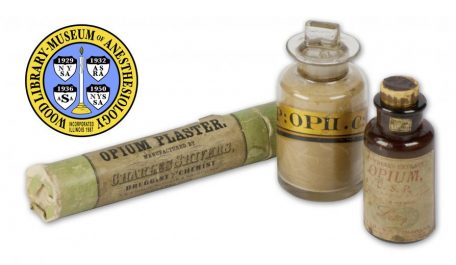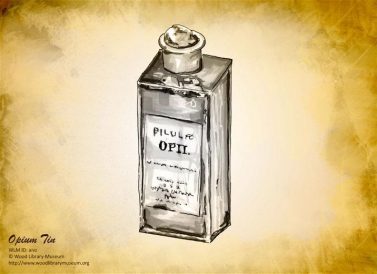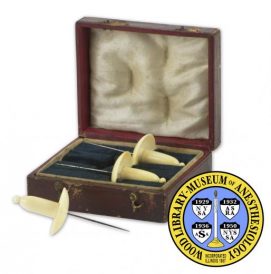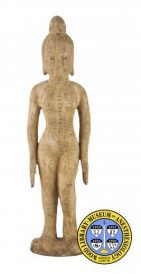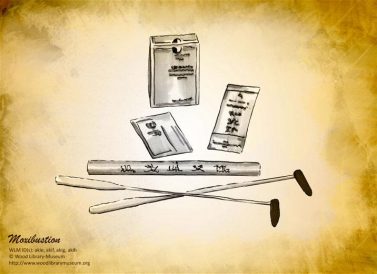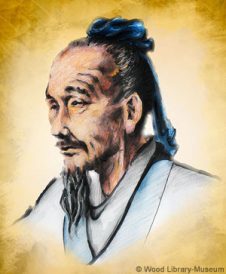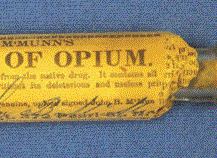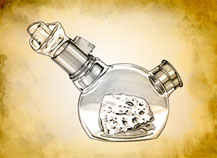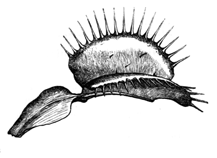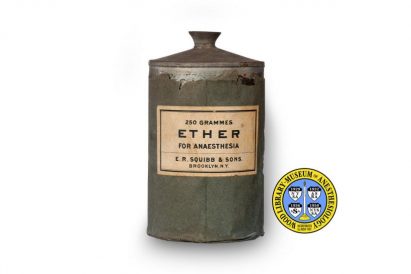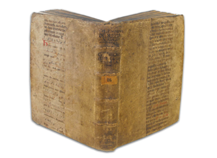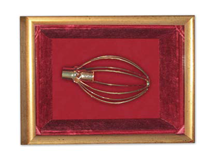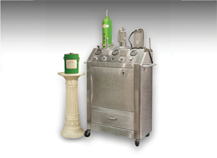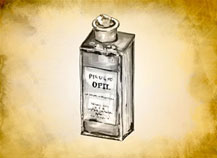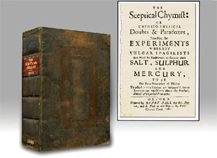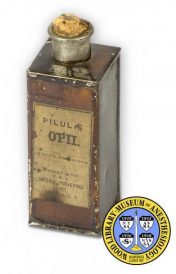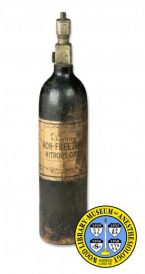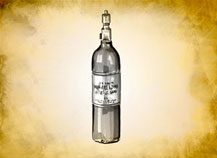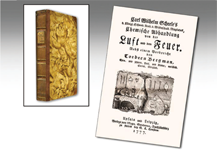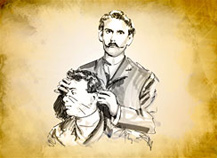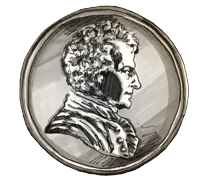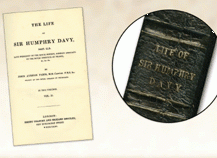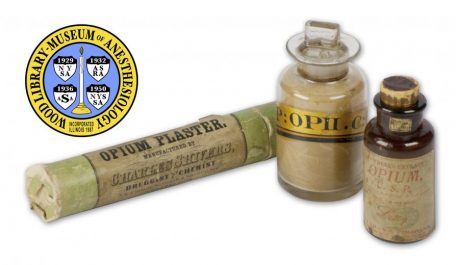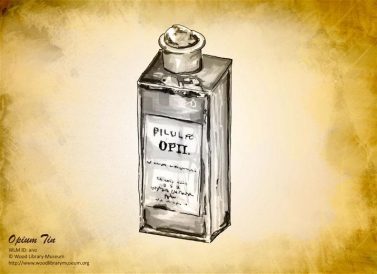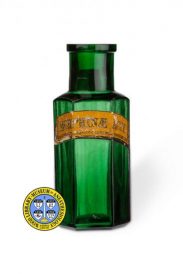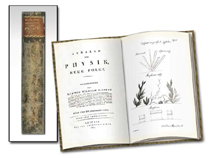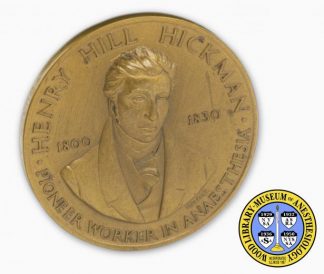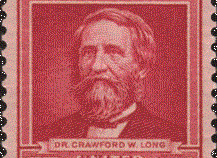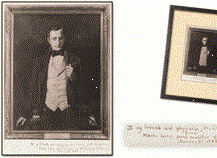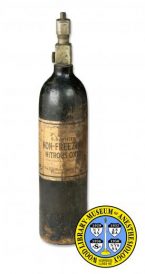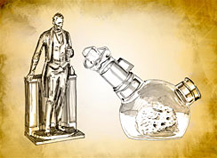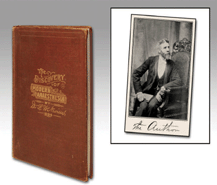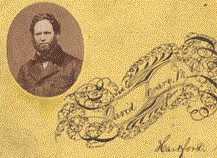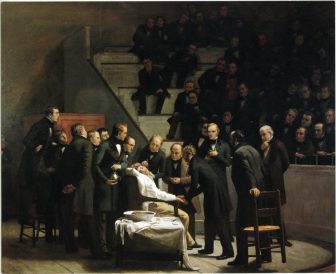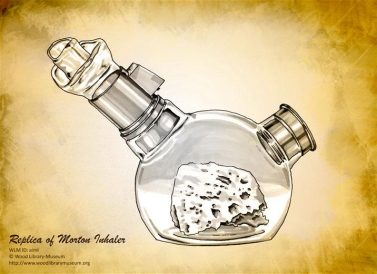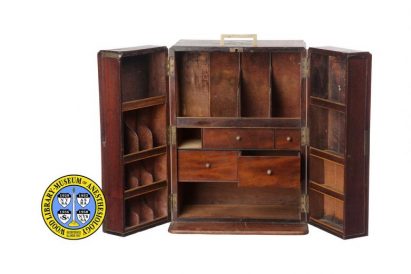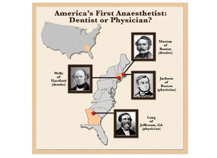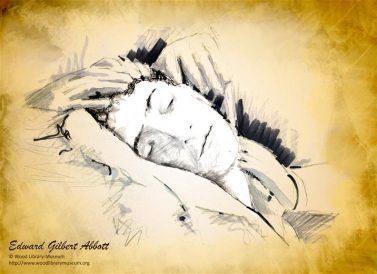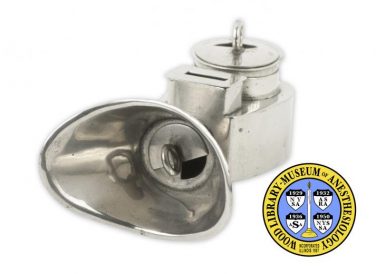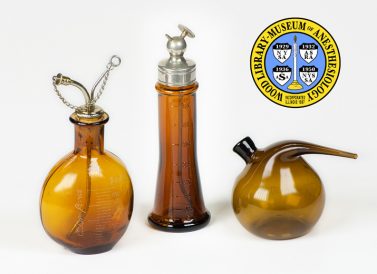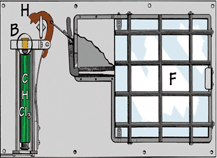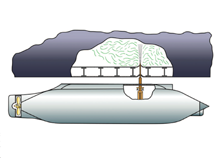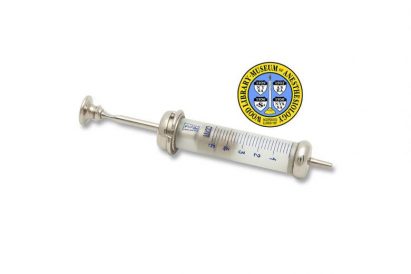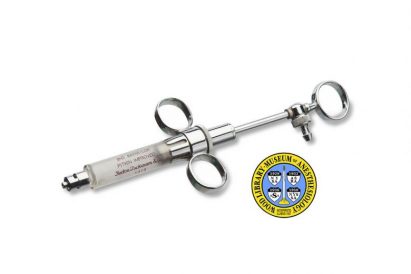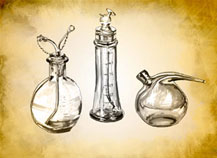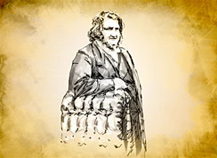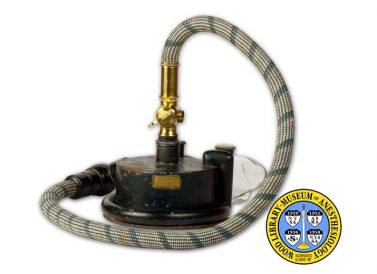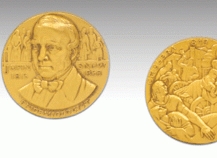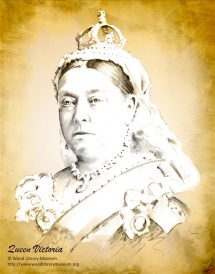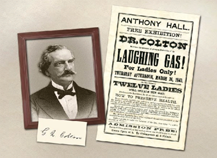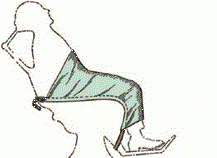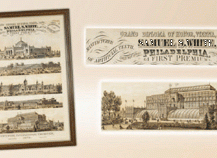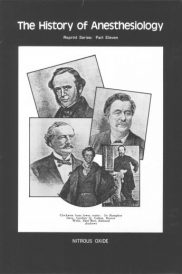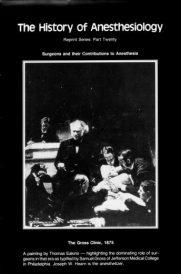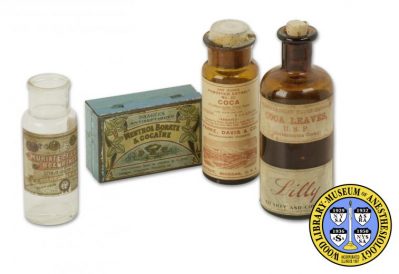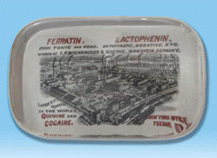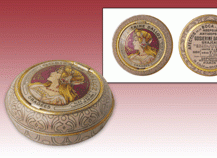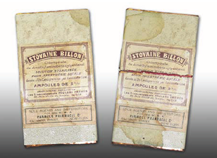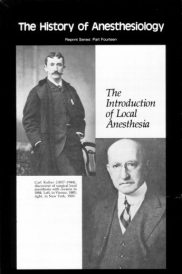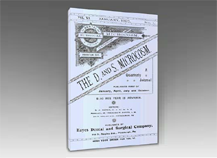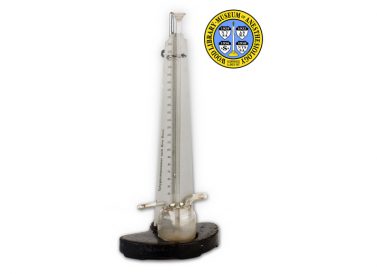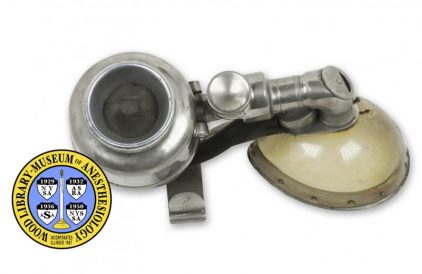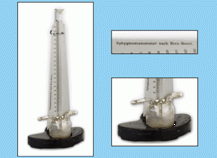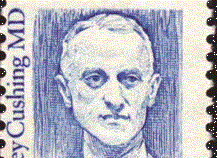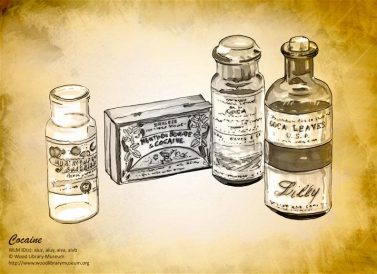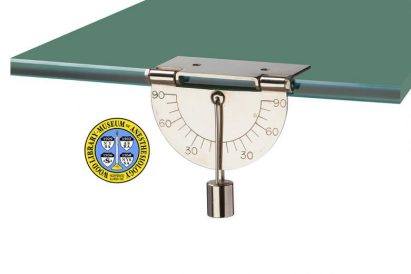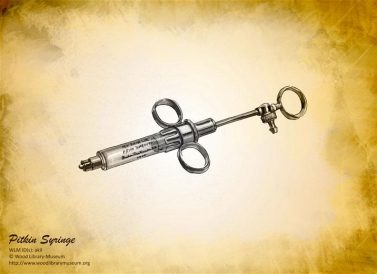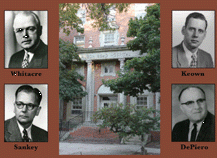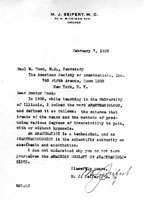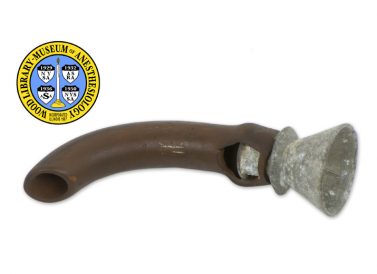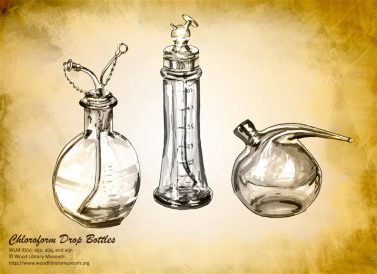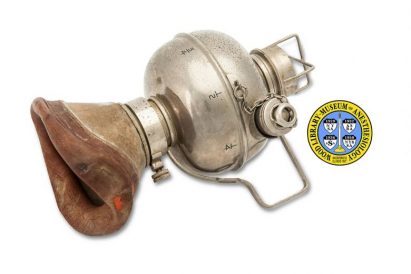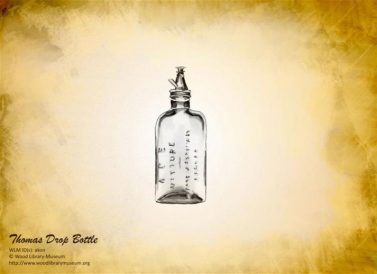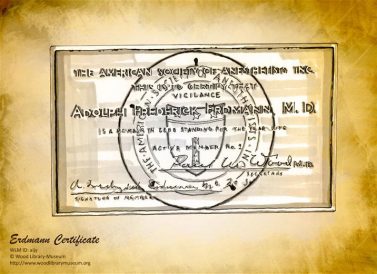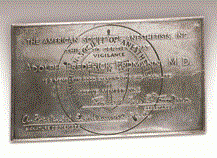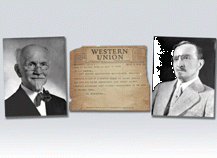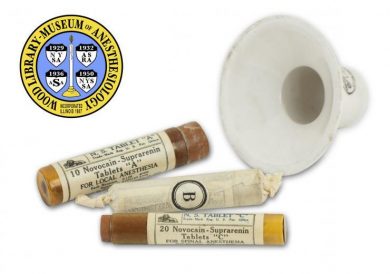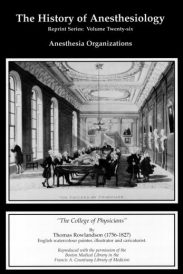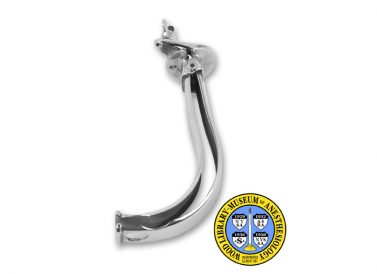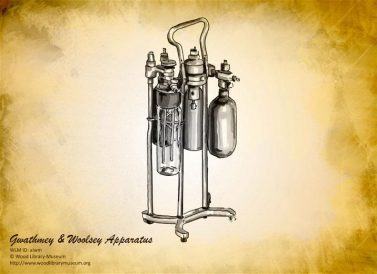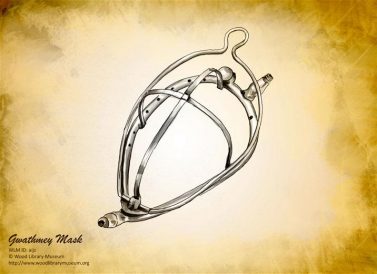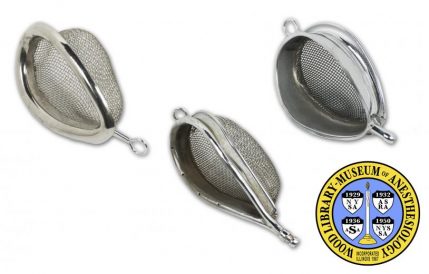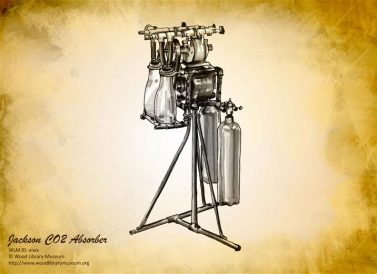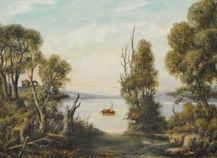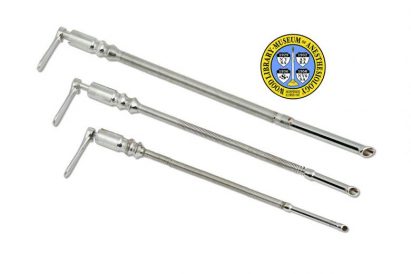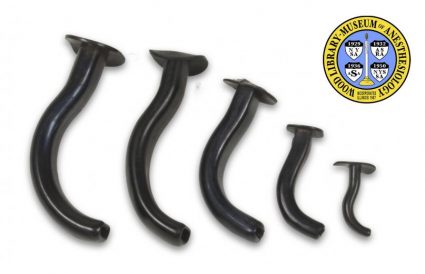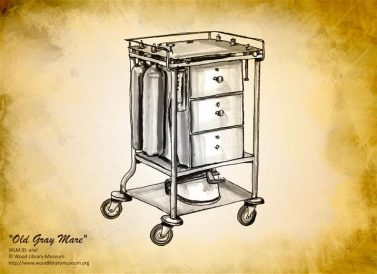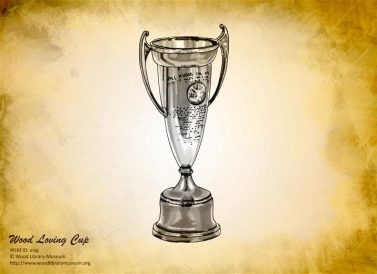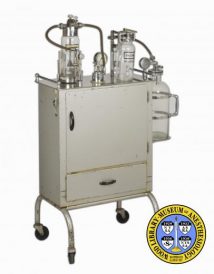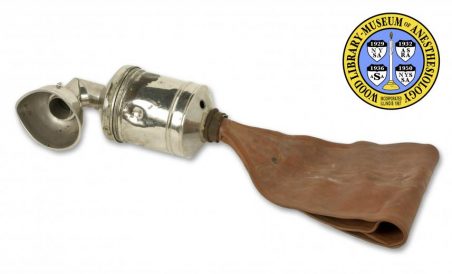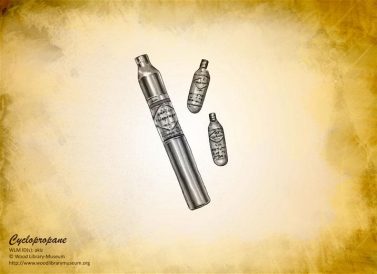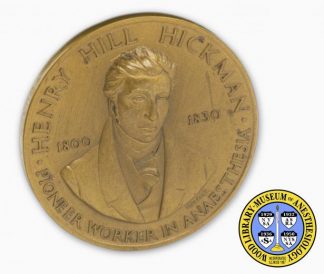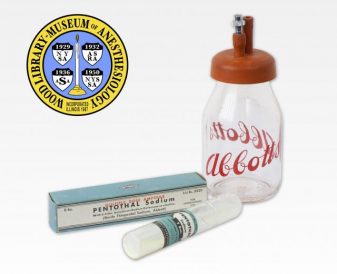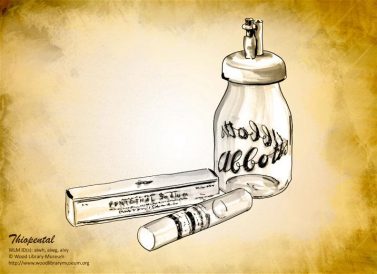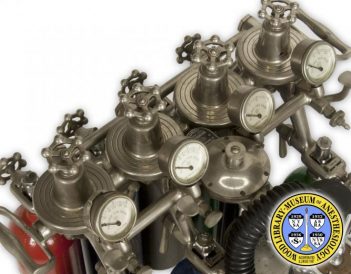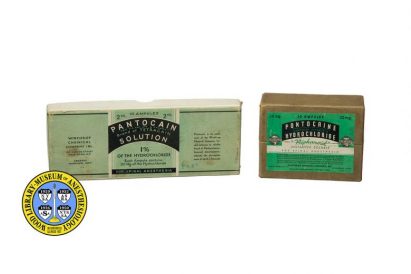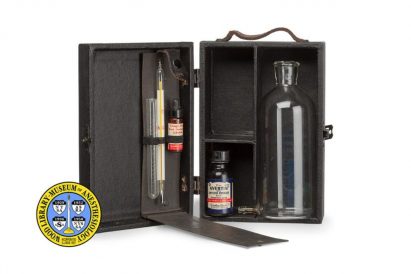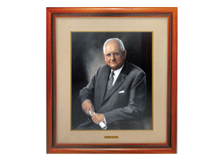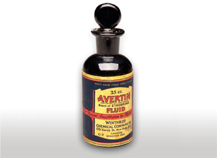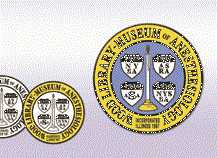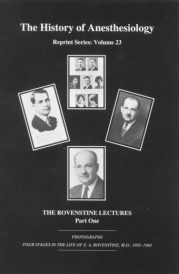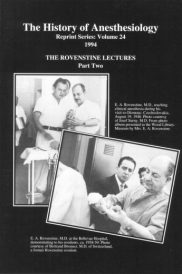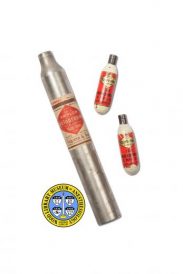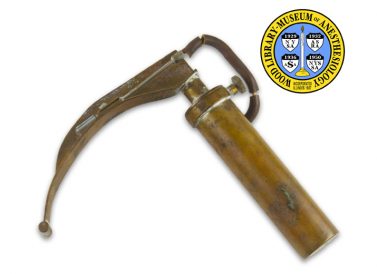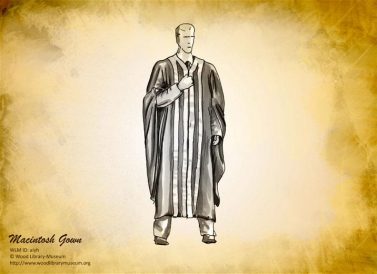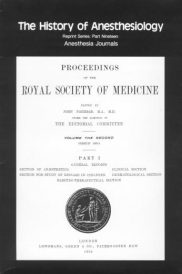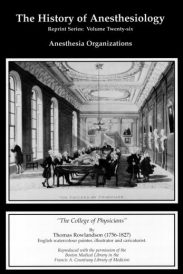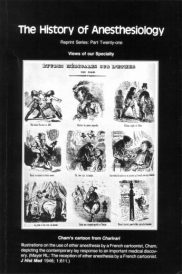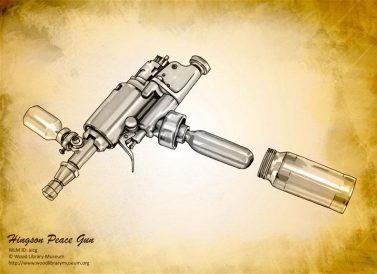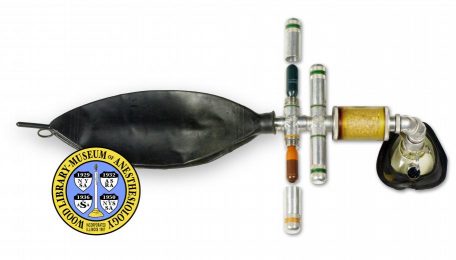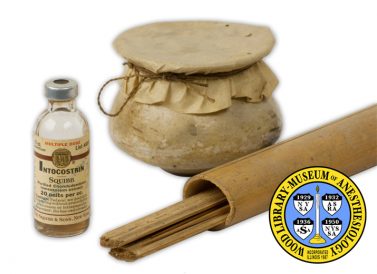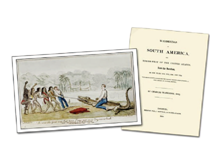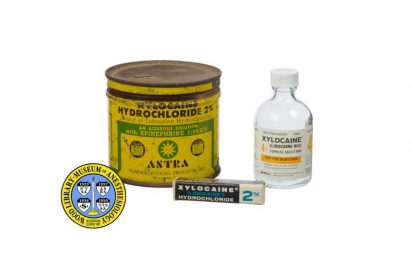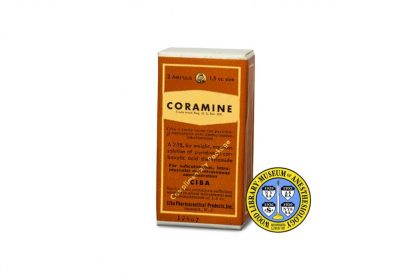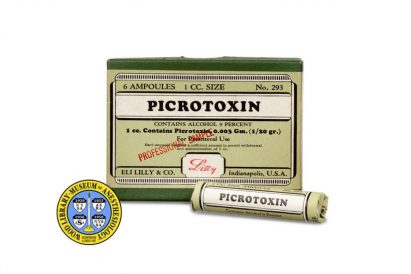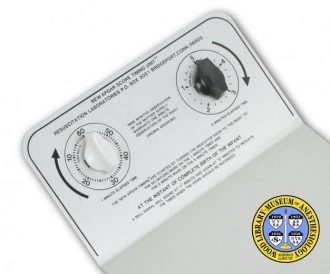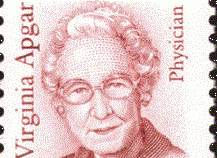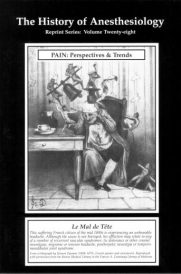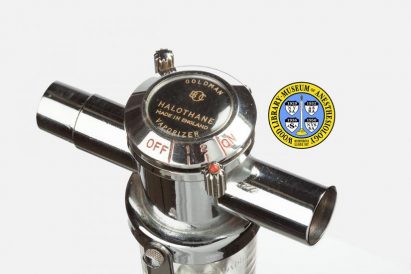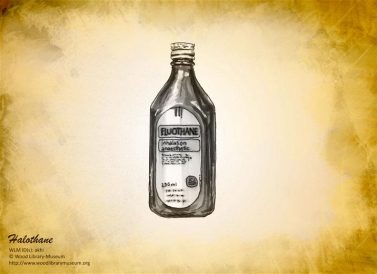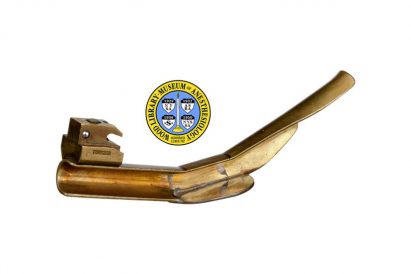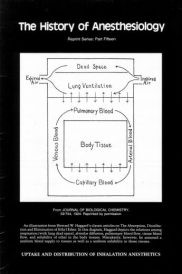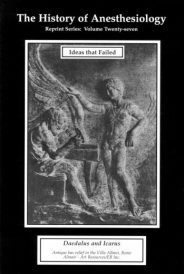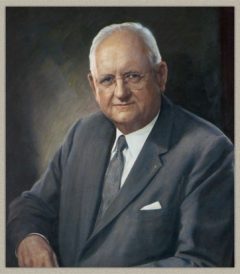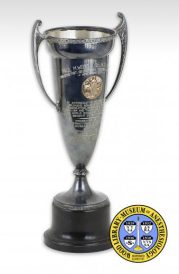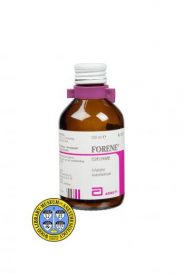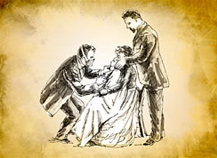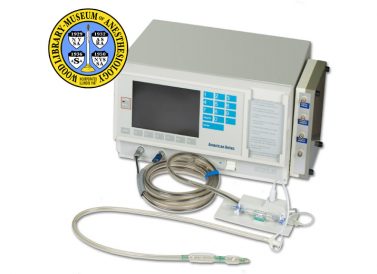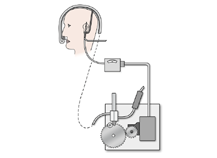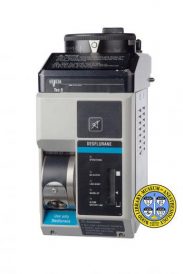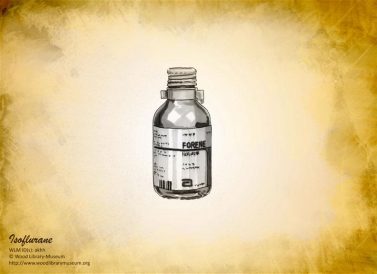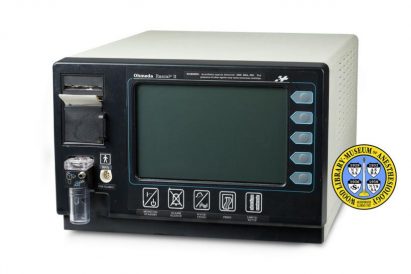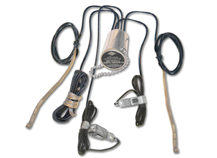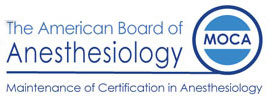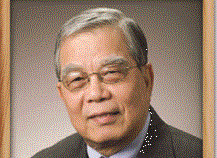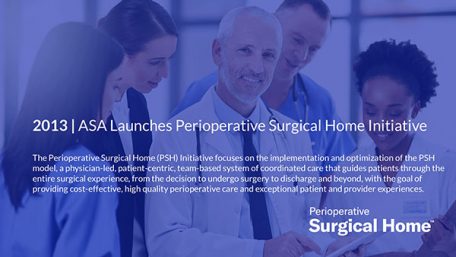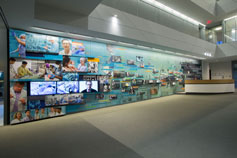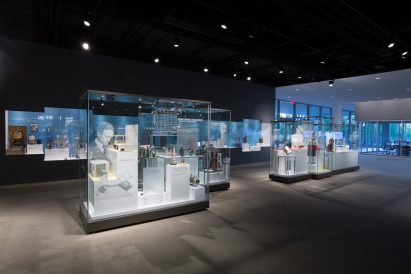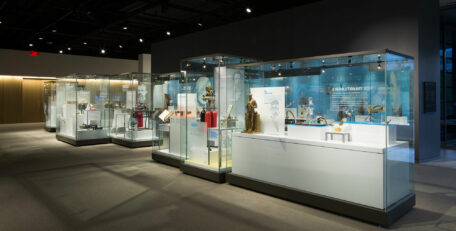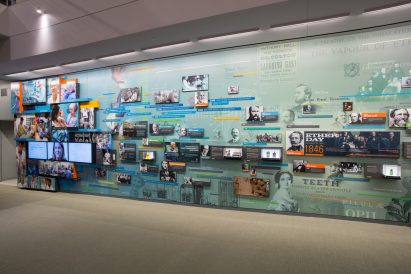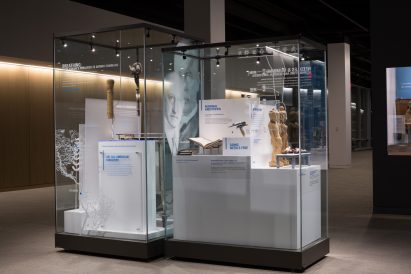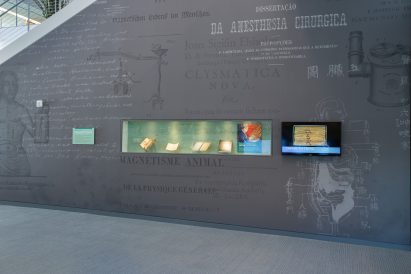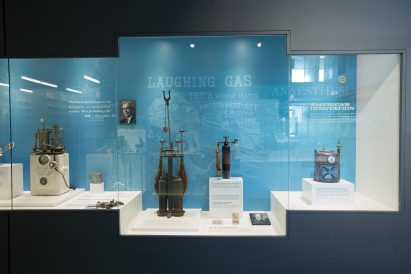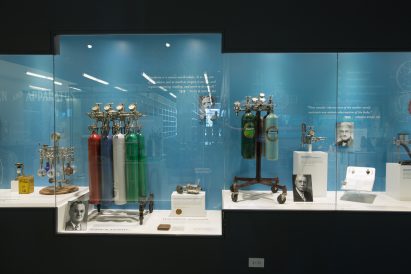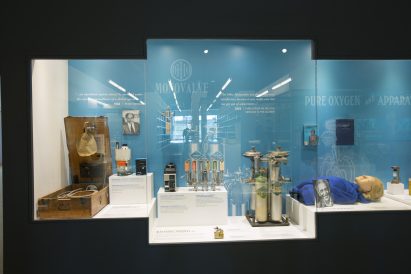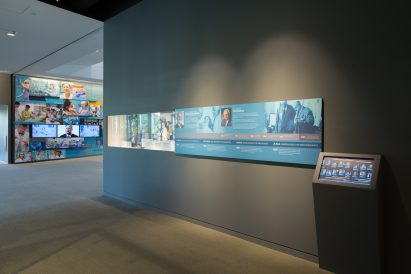While the use of opium poppy and other herbal remedies as anesthetics date back to early civilization, the first public demonstration of modern anesthesia was on October 16, 1846 (“Ether Day”). William T. G. Morton and surgeon John Collins Warren made anesthesia history at Massachusetts General Hospital with the successful use of diethyl ether “anaesthesia” to prevent pain during surgery. Since this historic milestone, advancements in anesthesia administration and newer anesthetics led to the medical specialty of anesthesiology in the early 20th century.
ca. 2250 BCE
Babylonians relieve toothache with henbane (Hyoscyamus niger).
ca. 1600 BCE
Acupuncture is being practiced in China, according to Shang Dynasty pictographs on bones and turtle shells.
Resources
WLM Online Museum Exhibits:
ASA Newsletter Articles:
Anesthesiology Reflections:
WLM Online Museum Exhibits:
ASA Newsletter Articles:
Anesthesiology Reflections:
ca. 1187 BCE
In Homer’s Odyssey, the Greek goddess Circe uses deliriant herbs (Mandragora and/or Datura) in a brew to seemingly transform Odysseus’ men into swine.
650 BCE - 393 AD
At the Oracle of Delphi, Apollo’s Pythian priestesses utter prophecies after breathing in fumes emanating from geologic faultlines beneath the Temple to Apollo. One of the inhaled gases may have been ethylene, an inhalational anesthetic which will be popular clinically by the mid-1920s AD.
ca. 600 BCE
India’s Sushruta uses cannabis vapors to sedate surgical patients. Over ensuing centuries, other herbs like aconitum would supplement that sedation in India and eventually in China.
ca. 400 BCE
Assyrians use carotid compression to produce brief unconsciousness before circumcision or cataract surgery. Egyptians employ the same technique for eye surgery.
ca. 350 BCE
Plato refers to ANAIΣΘHΣIA in his work Timaeus.
64
Dioscorides, a Greek surgeon in the Roman army of Emperor Nero, recommends mandrake boiled in wine to “cause the insensibility of those who are to be cut or cauterized.”
Resources
Anesthesiology Journal Articles:
- The Legacy of Atropos, the Fate Who Cut the Thread of Life
- More on the Legacy of Atropos, with Special Reference to Datura stramonium
- Anesthetic Uses of Hyoscine and Atropine Alkaloids in Surgical Arabic Book
- The Ancestors of Inhalational Anesthesia: The Soporific Sponges (XIth–XVIIth Centuries): How a Universally Recommended Medical Technique Was Abruptly Discarded
ca. 160
Hua Tuo (ca. 111 – 207 AD) performs surgery with his general anesthetic Mafeisan, a wine and herbal mixture.
Resources
ASA Newsletter Articles:
ASA Newsletter Articles:
ca. 800 – ca. 1200s
After herbal mixtures including opium, mandrake, henbane, and/or hemlock are steeped into a soporific or sleep-bearing sponge (“spongia somnifera”), the sponge is dampened so that anesthetic vapors or drippings can be applied to a patient’s nostrils. These sponges were likely historical cousins to the so-called Roman or Arabic sponges (used during crucifixions, surgeries, and other painful events).
Resources
WLM Rare Book Room – Digital Copies of Titles:
WLM Online Museum Exhibits:
Anesthesiology Reflections:
WLM Rare Book Room – Digital Copies of Titles:
WLM Online Museum Exhibits:
Anesthesiology Reflections:
ca. 1350
Inca shamans chewed coca leaves mixed with vegetable ash and dripped their cocaine-laden saliva into the wounds of patients.
1525
Paracelsus (1493–1541)—First to use ether on animals.
Resources
WLM Rare Book Room – Digital Copies of Titles:
Anesthesiology Reflections:
WLM Rare Book Room – Digital Copies of Titles:
Anesthesiology Reflections:
1540
German physician and botanist Valerius Cordus (1515–1544), synthesizes diethyl ether by distilling ethanol and sulphuric acid into what he called “sweet oil of vitriol.”
Resources
WLM Rare Book Room – Digital Copies of Titles:
WLM Online Museum Exhibits:
ASA Newsletter Articles:
Anesthesiology Reflections:
WLM Rare Book Room – Digital Copies of Titles:
WLM Online Museum Exhibits:
ASA Newsletter Articles:
Anesthesiology Reflections:
1659
The future “Sir Christopher Wren” and Anglo-Irish chemist Robert Boyle (1627–1691) pioneered intravenous therapy by injecting opium through a goose quill into a dog’s vein.
Resources
WLM Rare Book Room – Digital Copies of Titles:
WLM Library – Free eBooks:
WLM Online Museum Exhibits:
Anesthesiology Reflections:
WLM Rare Book Room – Digital Copies of Titles:
WLM Library – Free eBooks:
WLM Online Museum Exhibits:
Anesthesiology Reflections:
1771 - 1786
Joseph Priestley (1733–1804)—English chemist and natural philosopher, discovers “airs” of oxygen and nitrous oxide; the first to isolate oxygen.
Resources
WLM Rare Book Room – Digital Copies of Titles:
WLM Library – Free eBooks:
WLM Online Museum Exhibits:
ASA Newsletter Articles:
Anesthesiology Reflections:
WLM Rare Book Room – Digital Copies of Titles:
WLM Library – Free eBooks:
WLM Online Museum Exhibits:
ASA Newsletter Articles:
Anesthesiology Reflections:
1779
Franz Anton Mesmer (1734–1815)—In Mémoire sur la découverte du magnétisme animal, he describes using magnets and hypnosis to cure many ailments.
Resources
WLM Rare Book Room – Digital Copies of Titles:
WLM Rare Book Room – Digital Copies of Titles:
July, 1800
Humphry Davy (1778–1829)—In his Researches…, Davy observes “As nitrous oxide in its extensive operation appears capable of destroying physical pain, it may probably be used with advantage during surgical operations in which no great effusion of blood takes place.”
Resources
WLM Library – Free eBooks:
WLM Online Museum Exhibits:
ASA Newsletter Articles:
Anesthesiology Reflections:
WLM Library – Free eBooks:
WLM Online Museum Exhibits:
ASA Newsletter Articles:
Anesthesiology Reflections:
1804
Japan’s Hanaoka Seishu (1760-1835) formulates his general anesthetic Tsusensan.
Resources
ASA Newsletter Articles:
1805
Pharmacist Friedrich Sertürner (1783–1841)—Isolates a new substance from opium, which he later names “morphium” after Morpheus, the god of dreams.
Resources
WLM Rare Book Room – Digital Copies of Titles:
WLM Library – Free eBooks:
WLM Online Museum Exhibits:
Anesthesiology Reflections:
WLM Rare Book Room – Digital Copies of Titles:
WLM Library – Free eBooks:
WLM Online Museum Exhibits:
Anesthesiology Reflections:
1824
Henry Hill Hickman (1800-1830) describes carbon dioxide anesthesia for animals.
Resources
WLM Library – Free eBooks:
WLM Online Museum Exhibits:
WLM Library – Free eBooks:
WLM Online Museum Exhibits:
1842
William Clarke (1819‐1908)—In Rochester, New York, a medical student etherizes a single patient for a dental extraction.
Resources
WLM Rare Book Room – Digital Copies of Titles:
1842
Dr. Crawford W. Long (1815-1878) etherizes James Venable for removal of neck cysts on March 30, 1842. Dr. Long would become honored as the 1st anesthesiologist on a US Postage stamp (1940) and as the inspiration for the 1st “National Doctors Day” on March 30, 1991.
Resources
WLM Rare Book Room – Digital Copies of Titles:
WLM Library – Free eBooks:
- The History of Anesthesiology Reprint Series: Part 1 – An Account of the First Use of Sulphuric Ether
- The History of Anesthesiology Reprint Series: Part 16 – Famous Patients in Anesthesia – James Venable
WLM Online Museum Exhibits:
ASA Newsletter Articles:
Anesthesiology Reflections:
WLM Rare Book Room – Digital Copies of Titles:
WLM Library – Free eBooks:
- The History of Anesthesiology Reprint Series: Part 1 – An Account of the First Use of Sulphuric Ether
- The History of Anesthesiology Reprint Series: Part 16 – Famous Patients in Anesthesia – James Venable
WLM Online Museum Exhibits:
ASA Newsletter Articles:
Anesthesiology Reflections:
1845
Dr. Horace Wells (1815-1848)-After bravely volunteering to inhale nitrous oxide for his own dental extraction back in December of 1844, Dr. Wells demonstrates nitrous oxide anesthesia for a tooth extraction near Massachusetts General Hospital, but the partial anesthetic is judged a “humbug.”
Resources
WLM Rare Book Room – Digital Copies of Titles:
WLM Library – Free eBooks:
- The History of Anesthesiology Reprint Series: Part 11 – Nitrous Oxide
- The History of Anesthesiology Reprint Series: Part 16 – Famous Patients in Anesthesia – Under the Influence
- The History of Anesthesiology Reprint Series: Part 18 – Controversies in Anesthesia – Nitrous Oxide, by Wells
WLM Online Museum Exhibits:
ASA Newsletter Articles:
Anesthesiology Reflections:
WLM Rare Book Room – Digital Copies of Titles:
WLM Library – Free eBooks:
- The History of Anesthesiology Reprint Series: Part 11 – Nitrous Oxide
- The History of Anesthesiology Reprint Series: Part 16 – Famous Patients in Anesthesia – Under the Influence
- The History of Anesthesiology Reprint Series: Part 18 – Controversies in Anesthesia – Nitrous Oxide, by Wells
WLM Online Museum Exhibits:
ASA Newsletter Articles:
Anesthesiology Reflections:
1846
On October 16, 1846 William T. G. Morton (1819-1868) made history by being first in the world to publicly and successfully demonstrate the use of ether anesthesia for surgery. This occurred at what came to be called “The Ether Dome,” at Massachusetts General Hospital on patient Edward Gilbert Abbott. Surgeon John Collins Warren noted, “Gentlemen, this is no humbug.” Dr. Oliver Wendell Holmes, Sr. (1809-1894)-suggests the terms “anaesthetic” and “anaesthesia” in a letter to William T. G. Morton. News of Morton’s ether demonstration was carried by the paddle steamship Acadia from Boston to Dr. Francis Boott and then on to Dr. James Robinson (1813-1862), who extracted a tooth on December 19, 1846, under ether anesthesia. In 1847 Robinson authored one of the first textbooks on anesthesia: A Treatise on the Inhalation of the Vapour of Ether for the Prevention of Pain in Surgical Operations.* On December 21, Scottish surgeons in Dumfries, Scotland (Dr. William Scott) and in London (Dr. Robert Liston) amputate limbs of etherized patients- the first such surgical anesthetics in the British Isles. Liston commented, “This Yankee dodge beats mesmerism hollow.” Dr. Liston describes the surgery in a letter to Dr. Francis Boott, which is published in The Lancet. The WLM owns this letter.
Resources
WLM Rare Book Room – Digital Copies of Titles:
- Ether and Anesthesia
- Ether Controversy
- Mesmerism and Animal Magnetism
- 1896 Semi-Centennial of the First Successful Ether Demonstration
WLM Library – Free eBooks:
- * Dr. James Robinson’s book A treatise on the inhalation of the vapour of ether for the prevention of pain in surgical operations
- The History of Anesthesiology Reprint Series: Part 2 – Insensibility During Surgical Operations
- The History of Anesthesiology Reprint Series: Part 16 – Famous Patients in Anesthesia – Edward Gilbert Abbott
- Dr. Norman Bergman’s book The Genesis of Surgical Anesthesia
- Thomas E Keys’ book The History of Surgical Anesthesia
WLM Online Museum Exhibits:
ASA Newsletter Articles:
Anesthesiology Reflections:
- W. T. G. Morton’s “Letheon” Advertisement
- Long, Wells, Morton, or Jackson?
- Charles T. Jackson in “Ballou’s Pictorial”
- Morton in McClure’s Magazine
- “Old Ironsides” through the Holmes Stereoscope
- W. T. G. Morton’s Dana, Maritime Attorney
- The Red Barn by Vandam
- The Morton House I by Vandam
- The Morton House II by Vandam
- The Waters-Morton House by Vandam
- The Rider Tavern by Vandam
- The Barn by Vandam
- Early Fall at the Waters-Morton House by Vandam
- Vandam’s Headquarters Building of the American Society of
Anesthesiologists
WLM Anesthesiologists’ Famous Patients’:
WLM Rare Book Room – Digital Copies of Titles:
- Ether and Anesthesia
- Ether Controversy
- Mesmerism and Animal Magnetism
- 1896 Semi-Centennial of the First Successful Ether Demonstration
WLM Library – Free eBooks:
- * Dr. James Robinson’s book A treatise on the inhalation of the vapour of ether for the prevention of pain in surgical operations
- The History of Anesthesiology Reprint Series: Part 2 – Insensibility During Surgical Operations
- The History of Anesthesiology Reprint Series: Part 16 – Famous Patients in Anesthesia – Edward Gilbert Abbott
- Dr. Norman Bergman’s book The Genesis of Surgical Anesthesia
- Thomas E Keys’ book The History of Surgical Anesthesia
WLM Online Museum Exhibits:
ASA Newsletter Articles:
Anesthesiology Reflections:
- W. T. G. Morton’s “Letheon” Advertisement
- Long, Wells, Morton, or Jackson?
- Charles T. Jackson in “Ballou’s Pictorial”
- Morton in McClure’s Magazine
- “Old Ironsides” through the Holmes Stereoscope
- W. T. G. Morton’s Dana, Maritime Attorney
- The Red Barn by Vandam
- The Morton House I by Vandam
- The Morton House II by Vandam
- The Waters-Morton House by Vandam
- The Rider Tavern by Vandam
- The Barn by Vandam
- Early Fall at the Waters-Morton House by Vandam
- Vandam’s Headquarters Building of the American Society of
Anesthesiologists
WLM Anesthesiologists’ Famous Patients’:
1847
Prof. James Y. Simpson (1811-1870)-Scottish obstetrician begins administering chloroform to women for pain during childbirth. Chloroform quickly becomes a popular anesthetic for surgery and dental procedures as well. Chloroform was discovered independently in 1831 by the USA’s Samuel Guthrie, France’s Eugène Soubeiran, and Germany’s Justus von Liebig.
Resources
WLM Rare Book Room – Digital Copies of Titles:
WLM Library – Free eBooks:
- The History of Anesthesiology Reprint Series: Part 6 – Obstetric Anesthesia
- The History of Anesthesiology Reprint Series: Part 18 – Controversies in Anesthesia – Etherization in Childbirth
WLM Online Museum Exhibits:
ASA Newsletter Articles:
Anesthesiology Reflections:
- From Resuscitation to Extermination: Chloroforming Rodents
- Chloroforming or Etherizing Safecrackers
- Chloroform Blues
- Anesthetizing Enemy Sailors
- The 1847 Murphy Chloroform Inhaler
- Stewart’s Burglary-preventing Apparatus
- Liebig on the 100 Reichsmark Banknote
- An American Patent for the Schimmelbusch Mask
WLM Finding Aids:
WLM Rare Book Room – Digital Copies of Titles:
WLM Library – Free eBooks:
- The History of Anesthesiology Reprint Series: Part 6 – Obstetric Anesthesia
- The History of Anesthesiology Reprint Series: Part 18 – Controversies in Anesthesia – Etherization in Childbirth
WLM Online Museum Exhibits:
ASA Newsletter Articles:
Anesthesiology Reflections:
- From Resuscitation to Extermination: Chloroforming Rodents
- Chloroforming or Etherizing Safecrackers
- Chloroform Blues
- Anesthetizing Enemy Sailors
- The 1847 Murphy Chloroform Inhaler
- Stewart’s Burglary-preventing Apparatus
- Liebig on the 100 Reichsmark Banknote
- An American Patent for the Schimmelbusch Mask
WLM Finding Aids:
1853
Drs. Charles Pravaz (1791-1853) and Alexander Wood (1817-1884)-These men independently invented the hollow hypodermic needle, which will be attached to an earlier invention, the syringe popularized in 1845 by Ireland’s Francis Rynd.
Resources
WLM Online Museum Exhibits:
WLM Online Museum Exhibits:
1853 & 1857
Dr. John Snow (1813-1858)-A fulltime anesthetist since 1847, Dr. Snow popularizes obstetric anesthesia by chloroforming Queen Victoria for the birth of Prince Leopold (1853) and Princess Beatrice (1857). His books On the Inhalation of the Vapour of Ether** and On Chloroform and Other Anaesthetics*** enlightened physician-anesthetists. His sourcing of the 1854 London cholera epidemic to the Broad Street water pump founded epidemiology.
Resources
WLM Rare Book Room – Digital Copies of Titles:
WLM Library – Free eBooks:
- ** On the Inhalation of the Vapour of Ether
- *** On Chloroform and Other Anaesthetics (With a memoir of the author, by Benjamin W. Richardson)
- The History of Anesthesiology Reprint Series: Part 6 – Obstetric Anesthesia
- The History of Anesthesiology Reprint Series: Part 16 – Famous Patients in Anesthesia – Queen Victoria
- The History of Anesthesiology Reprint Series: Part 18 – Controversies in Anesthesia – Etherization in Childbirth
WLM Online Museum Exhibits:
ASA Newsletter Articles:
Anesthesiology Reflections:
- Belskie’s 1971 Medallion of John Snow
- The Blundell Gravitator
- Hart’s Chloroform Analgesia by “Reynolds Obstetrical Inhaler”
WLM Finding Aids:
WLM Anesthesiologists’ Famous Patients’:
WLM Rare Book Room – Digital Copies of Titles:
WLM Library – Free eBooks:
- ** On the Inhalation of the Vapour of Ether
- *** On Chloroform and Other Anaesthetics (With a memoir of the author, by Benjamin W. Richardson)
- The History of Anesthesiology Reprint Series: Part 6 – Obstetric Anesthesia
- The History of Anesthesiology Reprint Series: Part 16 – Famous Patients in Anesthesia – Queen Victoria
- The History of Anesthesiology Reprint Series: Part 18 – Controversies in Anesthesia – Etherization in Childbirth
WLM Online Museum Exhibits:
ASA Newsletter Articles:
Anesthesiology Reflections:
- Belskie’s 1971 Medallion of John Snow
- The Blundell Gravitator
- Hart’s Chloroform Analgesia by “Reynolds Obstetrical Inhaler”
WLM Finding Aids:
WLM Anesthesiologists’ Famous Patients’:
1863
“Professor” Gardner Quincy Colton (1814-1898) of the Cooper Institute in New York reintroduces nitrous oxide.
Resources
WLM Library – Free eBooks:
- The History of Anesthesiology Reprint Series: Part 11 – Nitrous Oxide
- The History of Anesthesiology Reprint Series: Part 16 – Famous Patients in Anesthesia – Under the Influence (G.Q. Colton)
WLM Online Museum Exhibits:
Anesthesiology Reflections:
WLM Library – Free eBooks:
- The History of Anesthesiology Reprint Series: Part 11 – Nitrous Oxide
- The History of Anesthesiology Reprint Series: Part 16 – Famous Patients in Anesthesia – Under the Influence (G.Q. Colton)
WLM Online Museum Exhibits:
Anesthesiology Reflections:
1868
Dr. Edmund Andrews (1824-1904) of Chicago proposes using nitrous oxide mixed with oxygen as an anesthetic in the Chicago Medical Examiner.
Resources
WLM Rare Book Room – Digital Copies of Titles:
WLM Library – Free eBooks:
- The History of Anesthesiology Reprint Series: Part 11 – Nitrous Oxide
- The History of Anesthesiology Reprint Series: Part 20 – Surgeons and Their Contributions to Anesthesia – Oxygen Mixture by E. Andrews
WLM Online Museum Exhibits:
WLM Rare Book Room – Digital Copies of Titles:
WLM Library – Free eBooks:
- The History of Anesthesiology Reprint Series: Part 11 – Nitrous Oxide
- The History of Anesthesiology Reprint Series: Part 20 – Surgeons and Their Contributions to Anesthesia – Oxygen Mixture by E. Andrews
WLM Online Museum Exhibits:
1884
Dr. Karl Koller (1857-1944)-Viennese ophthalmologist and colleague of Sigmund Freud, introduces cocaine as an anesthetic for eye surgery.
Resources
WLM Library – Free eBooks:
WLM Online Museum Exhibits:
Anesthesiology Reflections:
- Annie Oakley Guns Down “Cocaine Libel”
- A “Cocaine Paperweight” from C.F. Boehringer & Soehne
- A Tin of Borate-Menthol-Cocaine Dragées by Dalloz
- Fourneau Synthesizes Stovaine
- The “Blue Light Anaesthesia” of Redard
- Preparing Local Anesthetics with Kersten’s Apparatus
- Alvatunder Bottle by the Hisey Dental Manufacturing Company
WLM Library – Free eBooks:
WLM Online Museum Exhibits:
Anesthesiology Reflections:
- Annie Oakley Guns Down “Cocaine Libel”
- A “Cocaine Paperweight” from C.F. Boehringer & Soehne
- A Tin of Borate-Menthol-Cocaine Dragées by Dalloz
- Fourneau Synthesizes Stovaine
- The “Blue Light Anaesthesia” of Redard
- Preparing Local Anesthetics with Kersten’s Apparatus
- Alvatunder Bottle by the Hisey Dental Manufacturing Company
1884
Dr. William S. Halsted uses cocaine (1852-1922) for the first regional (mandibular or jaw) nerve block with cocaine.
Resources
WLM Library – Free eBooks:
WLM Online Museum Exhibits:
WLM Finding Aids:
WLM Library – Free eBooks:
WLM Online Museum Exhibits:
WLM Finding Aids:
1889
At the Philadelphia College of Dentistry, Henry I. Dorr, MD, DDS was appointed as the world’s 1st Professor of the Practice of Dentistry, Anaesthetics and Anaesthesia. The world’s 1st unidisciplinary “Professors of Anaesthesia” will follow in dentistry at Chicago’s American College of Dental Surgery (1892, George Leininger, MD) and in medicine at the New York Homeopathic Medical College (1903, T. Drysdale Buchanan, MD).
Resources
Anesthesiology Journal Articles:
- Thomas Drysdale Buchanan or Henry Isaiah Dorr: Give Credit to Both
- Henry Isaiah Dorr Was the First Person to Hold the Title Professor of Anaesthesia (See page 8 of the .PDF file; page 1160 of the text)
1891
From Pittsburgh, Pennsylvania, The Dental and Surgical Microcosm is published as the world’s first journal “devoted chiefly to the science of Anaesthesia and Anaesthetics.”
Resources
Anesthesiology Reflections:
Anesthesiology Reflections:
1893
The London Society of Anaesthetists, the world’s first anesthesia society, is formed in London, England.
1894
Medical students E. Amory Codman (1869-1940) and Harvey Cushing (1869-1939)-develop the first anesthesia record using observed respiratory rate and palpated pulse rate. By 1901, Cushing will add blood pressure measurement by Riva Rocci sphygmomanometry; by 1903, respiratory rate and heart rate as auscultated by precordial stethoscope (use of which was pioneered by Cushing on dogs and by his favorite physician-anesthetist, S. Griffith Davis, on patients).
Resources
WLM Library – Free eBooks:
- The History of Anesthesiology Reprint Series: Part 8 – Neuroanesthesia
- The History of Anesthesiology Reprint Series: Part 20 – Surgeons and Their Contributions to Anesthesia – Harvey Cushing
WLM Online Museum Exhibits:
ASA Newsletter Articles:
Anesthesiology Reflections:
WLM Library – Free eBooks:
- The History of Anesthesiology Reprint Series: Part 8 – Neuroanesthesia
- The History of Anesthesiology Reprint Series: Part 20 – Surgeons and Their Contributions to Anesthesia – Harvey Cushing
WLM Online Museum Exhibits:
ASA Newsletter Articles:
Anesthesiology Reflections:
1898
Dr. August Bier (1861-1949)-Conducts the first spinal anesthetic using cocaine; 10 years later, he popularized the intravenous regional (“Bier”) block.
Resources
WLM Library – Free eBooks:
- The History of Anesthesiology Reprint Series: Part 3 – Spinal Anesthesia
- The History of Anesthesiology Reprint Series: Part 14 – The Introduction of Local Anesthesia
- The History of Anesthesiology Reprint Series: Part 18 – Controversies in Anesthesia
WLM Online Museum Exhibits:
Anesthesiology Reflections:
WLM Finding Aids:
WLM Library – Free eBooks:
- The History of Anesthesiology Reprint Series: Part 3 – Spinal Anesthesia
- The History of Anesthesiology Reprint Series: Part 14 – The Introduction of Local Anesthesia
- The History of Anesthesiology Reprint Series: Part 18 – Controversies in Anesthesia
WLM Online Museum Exhibits:
Anesthesiology Reflections:
WLM Finding Aids:
1901
Caudal epidural analgesia is described independently by France’s Drs. Jean-Anthanase Sicard and Fernand Cathelin. Their innovation comes after an inadvertent epidural injection by Dr. J. Leonard Corning (1855-1923).
Resources
1902
Dr. Mathias J. Seifert of Chicago coins the words “anesthesiology” and “anesthesiologist.” He asserted that an “ANESTHETIST” is a technician and an “ANESTHESIOLOGIST” is the scientific authority on anesthesia and anesthetics.
Resources
WLM Archives:
WLM Archives:
1902
Dr. Frederic W. Hewitt administers a chloroform-ether mixture to the future King Edward VII. Perhaps tugging on the portly prince’s beard (to keep the royal airway open) inspired Hewitt by 1908 to design his oral “air-way.”
Resources
WLM Rare Book Room – Digital Copies of Titles:
WLM Online Museum Exhibits:
ASA Newsletter Articles:
WLM Rare Book Room – Digital Copies of Titles:
WLM Online Museum Exhibits:
ASA Newsletter Articles:
1905
Dr. A. Frederick Erdmann (1867-1953)-Founds the Long Island Society of Anesthetists (LISA), the first professional anesthesia society in the USA. (LISA membership starts as 9 total.)
Resources
WLM Library – Free eBooks:
- The History of Anesthesiology Reprint Series: Volume 26 – Anesthesia Organizations – Historical Development of the ASA
- “In the Beginning: Adolph Frederick Erdmann and the Long Island Society of Anesthetists” by James C. Erickson, III, M.D., M.Sc., excerpt from The American Society of Anesthesiologists: A Century of Challenges and Progress
WLM Online Museum Exhibits:
Anesthesiology Reflections:
WLM Finding Aids:
WLM Library – Free eBooks:
- The History of Anesthesiology Reprint Series: Volume 26 – Anesthesia Organizations – Historical Development of the ASA
- “In the Beginning: Adolph Frederick Erdmann and the Long Island Society of Anesthetists” by James C. Erickson, III, M.D., M.Sc., excerpt from The American Society of Anesthesiologists: A Century of Challenges and Progress
WLM Online Museum Exhibits:
Anesthesiology Reflections:
WLM Finding Aids:
1911
The Long Island Society is renamed the New York Society of Anesthetists (NYSA). (NYSA membership reaches 23 in 1911.)
Resources
WLM Library – Free eBooks:
- The History of Anesthesiology Reprint Series: Volume 26 – Anesthesia Organizations – Historical Development of the ASA
- “The New York Society of Anesthetists: Building the Foundation” by Douglas R. Bacon, M.D., M.A., excerpt from The American Society of Anesthesiologists: A Century of Challenges and Progress
WLM Finding Aids:
WLM Library – Free eBooks:
- The History of Anesthesiology Reprint Series: Volume 26 – Anesthesia Organizations – Historical Development of the ASA
- “The New York Society of Anesthetists: Building the Foundation” by Douglas R. Bacon, M.D., M.A., excerpt from The American Society of Anesthesiologists: A Century of Challenges and Progress
WLM Finding Aids:
1914
The 1st of 2 editions of Anesthesia, the USA’s first such comprehensive textbook, is published by Dr. James T. Gwathmey, the 1912 NYSA President.
Resources
WLM Online Museum Exhibits:
ASA Newsletter Articles:
- September 1995 – In Dr. Gwathmey’s Own Words
- September 2008 – ‘Year of the Airway’ – Dr. Gwathmey’s Airway
Anesthesiology Reflections:
WLM Online Museum Exhibits:
ASA Newsletter Articles:
- September 1995 – In Dr. Gwathmey’s Own Words
- September 2008 – ‘Year of the Airway’ – Dr. Gwathmey’s Airway
Anesthesiology Reflections:
1914
Dr. Dennis E. Jackson develops a carbon dioxide (CO2) absorbing anesthesia system, allowing for a patient to re-breathe their exhaled air containing the anesthetic, cleansed of the carbon dioxide, resulting in the use of less anesthetic and the avoidance of waste. Ten years later, Dr. Ralph Waters develops the first simple and easily transportable absorber, known as the “Waters Canister” and the “Waters To-and-Fro.”
Resources
WLM Library – Free eBooks:
WLM Online Museum Exhibits:
Anesthesiology Reflections:
WLM Multimedia Collection:
- Dr. Dennis E. Jackson has been interviewed for The John W. Pender Collection of the Living History of Anesthesiology.
WLM Library – Free eBooks:
WLM Online Museum Exhibits:
Anesthesiology Reflections:
WLM Multimedia Collection:
- Dr. Dennis E. Jackson has been interviewed for The John W. Pender Collection of the Living History of Anesthesiology.
1916
The 1st of 7 editions of The Art of Anaesthesia is published by Dr. Paluel J. Flagg, the 1919-1920 ASA President.
Resources
WLM Online Museum Exhibits:
ASA Newsletter Articles:
Anesthesiology Reflections:
WLM Online Museum Exhibits:
ASA Newsletter Articles:
Anesthesiology Reflections:
1920
Arthur Guedel publishes his eye signs of ether anesthesia in the American Journal of Surgery. His Guedel (oral) airway is still used today, and he has been memorialized by the Arthur E. Guedel Memorial Anesthesia Center, San Francisco, CA.
Resources
WLM Rare Book Room – Digital Copies of Titles:
WLM Library – Free eBooks:
WLM Online Museum Exhibits:
ASA Newsletter Articles:
WLM Rare Book Room – Digital Copies of Titles:
WLM Library – Free eBooks:
WLM Online Museum Exhibits:
ASA Newsletter Articles:
1922
From Cleveland, Ohio, Current Researches in Anesthesia and Analgesia is launched by Francis H. “Frank” McMechan (1879-1939) as the world’s first journal published by an anesthesia society, the International Anesthesia Research Society.
Resources
WLM Online Museum Exhibits:
- Wood Loving Cup – Awarded by International Anesthesia Research Society
ASA Newsletter Articles:
WLM Online Museum Exhibits:
- Wood Loving Cup – Awarded by International Anesthesia Research Society
ASA Newsletter Articles:
1923
Dr. Isabella Herb administers the first ethylene-oxygen surgical anesthetic. She demonstrated the remarkable trance-like state that low-dose ethylene could induce in human subjects.
Resources
WLM Online Museum Exhibits:
WLM Finding Aids:
- Arno Luckhardt Collection – A colleague of Dr. Herb, who worked with the anesthetic ethylene with Dr. Herb
WLM Online Museum Exhibits:
WLM Finding Aids:
- Arno Luckhardt Collection – A colleague of Dr. Herb, who worked with the anesthetic ethylene with Dr. Herb
1927
Dr. Ralph M. Waters arrives at the University of Wisconsin, Madison. From there he will train his anesthesia residents (Waters’ trainees were affectionately known as “Aqualumni”) in one of the world’s 1st university-based residency training programs in anesthesiology. Waters also will pioneer carbon dioxide absorbing apparatus (To-and-Fro Canister), will clinically introduce intravenous sodium thiopental and inhalational anesthetic cyclopropane, and will become the ASA President in 1945.
Resources
WLM Library – Free eBooks:
- Holding Court With the Ghost of Gilman Terrace: Selected Writings of Ralph Milton Waters M.D.
- Ralph Milton Waters, M.D.: Mentor to a Profession (Proceedings of the Ralph M. Waters Symposium on Professionalism in Anesthesiology, Madison, Wisconsin 2002).
- The History of Anesthesiology Reprint Series: Part 5 – Carbon Dioxide Absorption
- The History of Anesthesiology Reprint Series: Part 21 – Views of Our Specialty – Ralph M. Waters “Pioneering in Anesthesiology”
WLM Online Museum Exhibits:
- Waters Carbon Dioxide (CO2) Absorber
- Cyclopropane
- Hickman Medal – Awarded to Dr. Waters
- Thiopental
ASA Newsletter Articles:
Anesthesiology Reflections:
WLM Finding Aids:
- Ralph M. Waters Collection
- Noel A. Gillespie Collection – A colleague and biographer of Dr. Waters
WLM Library – Free eBooks:
- Holding Court With the Ghost of Gilman Terrace: Selected Writings of Ralph Milton Waters M.D.
- Ralph Milton Waters, M.D.: Mentor to a Profession (Proceedings of the Ralph M. Waters Symposium on Professionalism in Anesthesiology, Madison, Wisconsin 2002).
- The History of Anesthesiology Reprint Series: Part 5 – Carbon Dioxide Absorption
- The History of Anesthesiology Reprint Series: Part 21 – Views of Our Specialty – Ralph M. Waters “Pioneering in Anesthesiology”
WLM Online Museum Exhibits:
- Waters Carbon Dioxide (CO2) Absorber
- Cyclopropane
- Hickman Medal – Awarded to Dr. Waters
- Thiopental
ASA Newsletter Articles:
Anesthesiology Reflections:
WLM Finding Aids:
- Ralph M. Waters Collection
- Noel A. Gillespie Collection – A colleague and biographer of Dr. Waters
1929
The Anaesthetists’ Travel Club is organized by Dr. John S. Lundy, who will popularize use of the intravenous anesthetic thiopental (Pentothal) and will become the ASA President in 1946. The popularity of thiopental-as a swift-onset intravenous agent for inducing general anesthesia-will pave the way for other totally unrelated intravenous induction agents, such as ketamine, etomidate, and propofol.
Resources
WLM Library – Free eBooks:
- The History of Anesthesiology Reprint Series: Volume 26 – Anesthesia Organizations – Anaesthetists’ Travel Club
- The History of Anesthesiology Reprint Series: Volume 30 – Genetic Aspects of the Practice of Anesthesiology – Thiopental
WLM Online Museum Exhibits:
- Thiopental
- Lundy Rochester Model Machine
- Pontocaine (tetracaine) – Dr. Lundy was one of the first physicians in the U.S. to use tetracaine in the clinical setting
WLM Finding Aids:
WLM Multimedia Collection:
- Dr. John S. Lundy has been interviewed for The John W. Pender Collection of the Living History of Anesthesiology.
WLM Library – Free eBooks:
- The History of Anesthesiology Reprint Series: Volume 26 – Anesthesia Organizations – Anaesthetists’ Travel Club
- The History of Anesthesiology Reprint Series: Volume 30 – Genetic Aspects of the Practice of Anesthesiology – Thiopental
WLM Online Museum Exhibits:
- Thiopental
- Lundy Rochester Model Machine
- Pontocaine (tetracaine) – Dr. Lundy was one of the first physicians in the U.S. to use tetracaine in the clinical setting
WLM Finding Aids:
WLM Multimedia Collection:
- Dr. John S. Lundy has been interviewed for The John W. Pender Collection of the Living History of Anesthesiology.
1933
To the NYSA (the future ASA), Dr. Paul M. Wood formally donates his personal collections, which form the basis of his future namesake, the Wood Library-Museum of Anesthesiology.
Resources
WLM Feature:
- Paul Wood, M.D. 1894 – 1963 – (Includes audio lecture given by Dr. Wood in 1955 – The History of Anesthesia Apparatus)
WLM Archives:
WLM Online Museum Exhibits:
- Avertin Kit – Designed by Dr. Wood
ASA Newsletter Articles:
- August 1989 – Wood Library-Museum Storehouse of Memories
- September 1994 – Dr. Paul M. Wood
- September 2005 – History of the Wood Library-Museum
- September 2006 – Wood Library-Museum
Anesthesiology Reflections:
WLM Feature:
- Paul Wood, M.D. 1894 – 1963 – (Includes audio lecture given by Dr. Wood in 1955 – The History of Anesthesia Apparatus)
WLM Archives:
WLM Online Museum Exhibits:
- Avertin Kit – Designed by Dr. Wood
ASA Newsletter Articles:
- August 1989 – Wood Library-Museum Storehouse of Memories
- September 1994 – Dr. Paul M. Wood
- September 2005 – History of the Wood Library-Museum
- September 2006 – Wood Library-Museum
Anesthesiology Reflections:
1935
Dr. Emery A. Rovenstine arrives at Bellevue Hospital in New York to establish a premiere residency there. Having co-pioneered in the 1930s the use of cyclopropane and punch-card databases of his anesthesia cases, he co-founds the American Board of Anesthesiology and New York’s PostGraduate Assembly in Anesthesiology. He will serve as the 1943-1944 ASA President and will receive the ASA’s Distinguished Service Award in 1957.
Resources
WLM Library – Free eBooks:
- The History of Anesthesiology Reprint Series: Volume 23 – The Rovenstine Lectures, part 1
- The History of Anesthesiology Reprint Series: Volume 24 – The Rovenstine Lectures, part 2
WLM Online Museum Exhibits:
WLM Finding Aids:
WLM Library – Free eBooks:
- The History of Anesthesiology Reprint Series: Volume 23 – The Rovenstine Lectures, part 1
- The History of Anesthesiology Reprint Series: Volume 24 – The Rovenstine Lectures, part 2
WLM Online Museum Exhibits:
WLM Finding Aids:
1936
The New York Society of Anesthetists is renamed the American Society of Anesthetists. (The ASA’s membership reaches 487 in 1936.)
Resources
WLM Library – Free eBooks:
- The History of Anesthesiology Reprint Series: Volume 26 – Anesthesia Organizations – Historical Development of the ASA
- “The Creation of the ASA” by Douglas R. Bacon, M.D., M.A.
ASA Newsletter Articles:
WLM Finding Aids:
WLM Library – Free eBooks:
- The History of Anesthesiology Reprint Series: Volume 26 – Anesthesia Organizations – Historical Development of the ASA
- “The Creation of the ASA” by Douglas R. Bacon, M.D., M.A.
ASA Newsletter Articles:
WLM Finding Aids:
1937
Prof. Robert R. Macintosh-Appointed to the world’s 1st endowed chair in Anaesthetics, Oxford’s Nuffield Professor Macintosh would introduce his curved laryngoscope blade- the world’s favorite- in 1943 and be knighted in 1955 for redesigning aviators’ life jackets.
Resources
WLM Online Museum Exhibits:
WLM Multimedia Collection:
- Dr. Robert R. Macintosh has been interviewed for The John W. Pender Collection of the Living History of Anesthesiology.
WLM Online Museum Exhibits:
WLM Multimedia Collection:
- Dr. Robert R. Macintosh has been interviewed for The John W. Pender Collection of the Living History of Anesthesiology.
1940
Two years after forming as a subsidiary to the American Board of Surgery and the year after administering its first written examination, the American Board of Anesthesiology (ABA) is granted independent board status. The ABA helped define anesthesiology as a medical specialty and provided the American medical establishment with formal recognition of physicians specializing in the art and science of anesthesia. An ABA founder, Dr. Paul M. Wood also serves as Business Manager for Anesthesiology, the journal that the ASA begins publishing in July of 1940.
Resources
WLM Library – Free eBooks:
- The History of Anesthesiology Reprint Series: Part 19 – Anesthesia Journals – Anesthesiology Journal
- The History of Anesthesiology Reprint Series: Volume 26 – Anesthesia Organizations – ABA
- “The Creation of Anesthesiology” by Douglas R. Bacon, M.D., M.A.
WLM Finding Aids:
- Stuart C. Cullen Collection – Contains American Board of Anesthesiology material.
- American Board of Anesthesiology Collection
WLM Multimedia Collection:
- The following Anesthesiology journal Editors-in-Chief have participated in interviews for The John W. Pender Collection of the Living History of Anesthesiology.
- Anesthesiology Editor-in-Chief (1971-1973) Dr. Arthur S. Keats
(Keats, Arthur S./M.T. Pepper Jenkins (1988)) – VIEWABLE ONLINE
Dr. Keats has also participated in the interviews of the following doctors:- (Arens, James F./Arthur S. Keats (1996))
- (Fink, B. Raymond/Arthur S. Keats (1988))
- (Stephenson, Betty P./James F Arens, Arthur S. Keats (2002))
- Anesthesiology Editor-in-Chief (1986-1996) Dr. Lawrence J. Saidman
(Saidman, Lawrence J./Thomas Hornbein (1997)) – VIEWABLE ONLINE - Anesthesiology Editor-in-Chief (1997-2007) Dr. Michael M. Todd
(Todd, Michael M./David S. Warner (2010)) – VIEWABLE ONLINE - Anesthesiology Editor-in-Chief (1959-1962) Dr. James E. Eckenhoff was interviewed in 1988 by Anesthesiology Editor-in-Chief (1963-1970) Dr. Leroy D. Vandam. Dr. Eckenhoff was also interviewed in 1982 by Drs. Edward A. Brunner and Harry W. Linde.
Dr. Eckenhoff has also participated in the interviews of the following doctors:- (Macintosh, Sir Robert/James E. Eckenhoff (1983))
- (Dripps, Robert D./Drs. Prevoznik, Dumke, Eckenhoff, Vandam (1988))
- Anesthesiology Editor-in-Chief (1963-1970) Dr. Leroy D. Vandam
(Vandam, Leroy D./Elliott V. Miller (1980))
Dr. Vandam has also participated in the interviews of the following doctors:- (Adriani, John/Leroy D. Vandam (1977))
- (Dripps, Robert D./Drs. Prevoznik, Dumke, Eckenhoff, Vandam (1988))
- (Dumke, Paul R./Leroy D. Vandam (1985))
- (Eckenhoff, James E./Leroy D. Vandam (1988))
- (Greene, Nicholas M./Leroy D. Vandam (1985))
- (Vandam, Leroy D./Elliott V. Miller (1980))
- (Hershey, S. G./Leroy D. Vandam (1987))
- Anesthesiology Editor-in-Chief (1973-1976) Dr. Nicholas M. Greene
(Greene, Nicholas M./Leroy D. Vandam (1985))
Dr. Greene has also participated in the interview of Dr. Torsten Gordh: - Anesthesiology Editor-in-Chief (1980-1985) Dr. John D. Michenfelder
(Michenfelder, John D./Alan D. Sessler (1991)) - Anesthesiology Editor-in-Chief (1976-1979) Dr. C. Philip Larson has participated in the interview of Dr. William K. Hamilton:
- (Hamilton, William K./C. Philip Larson (1983))
- Anesthesiology Editor-in-Chief (2007-present) Dr. James C. Eisenach, M.D. has participated in the interview of Dr. Francis M. James:
- Anesthesiology Editor-in-Chief (1971-1973) Dr. Arthur S. Keats
WLM Library – Free eBooks:
- The History of Anesthesiology Reprint Series: Part 19 – Anesthesia Journals – Anesthesiology Journal
- The History of Anesthesiology Reprint Series: Volume 26 – Anesthesia Organizations – ABA
- “The Creation of Anesthesiology” by Douglas R. Bacon, M.D., M.A.
WLM Finding Aids:
- Stuart C. Cullen Collection – Contains American Board of Anesthesiology material.
- American Board of Anesthesiology Collection
WLM Multimedia Collection:
- The following Anesthesiology journal Editors-in-Chief have participated in interviews for The John W. Pender Collection of the Living History of Anesthesiology.
- Anesthesiology Editor-in-Chief (1971-1973) Dr. Arthur S. Keats
(Keats, Arthur S./M.T. Pepper Jenkins (1988)) – VIEWABLE ONLINE
Dr. Keats has also participated in the interviews of the following doctors:- (Arens, James F./Arthur S. Keats (1996))
- (Fink, B. Raymond/Arthur S. Keats (1988))
- (Stephenson, Betty P./James F Arens, Arthur S. Keats (2002))
- Anesthesiology Editor-in-Chief (1986-1996) Dr. Lawrence J. Saidman
(Saidman, Lawrence J./Thomas Hornbein (1997)) – VIEWABLE ONLINE - Anesthesiology Editor-in-Chief (1997-2007) Dr. Michael M. Todd
(Todd, Michael M./David S. Warner (2010)) – VIEWABLE ONLINE - Anesthesiology Editor-in-Chief (1959-1962) Dr. James E. Eckenhoff was interviewed in 1988 by Anesthesiology Editor-in-Chief (1963-1970) Dr. Leroy D. Vandam. Dr. Eckenhoff was also interviewed in 1982 by Drs. Edward A. Brunner and Harry W. Linde.
Dr. Eckenhoff has also participated in the interviews of the following doctors:- (Macintosh, Sir Robert/James E. Eckenhoff (1983))
- (Dripps, Robert D./Drs. Prevoznik, Dumke, Eckenhoff, Vandam (1988))
- Anesthesiology Editor-in-Chief (1963-1970) Dr. Leroy D. Vandam
(Vandam, Leroy D./Elliott V. Miller (1980))
Dr. Vandam has also participated in the interviews of the following doctors:- (Adriani, John/Leroy D. Vandam (1977))
- (Dripps, Robert D./Drs. Prevoznik, Dumke, Eckenhoff, Vandam (1988))
- (Dumke, Paul R./Leroy D. Vandam (1985))
- (Eckenhoff, James E./Leroy D. Vandam (1988))
- (Greene, Nicholas M./Leroy D. Vandam (1985))
- (Vandam, Leroy D./Elliott V. Miller (1980))
- (Hershey, S. G./Leroy D. Vandam (1987))
- Anesthesiology Editor-in-Chief (1973-1976) Dr. Nicholas M. Greene
(Greene, Nicholas M./Leroy D. Vandam (1985))
Dr. Greene has also participated in the interview of Dr. Torsten Gordh: - Anesthesiology Editor-in-Chief (1980-1985) Dr. John D. Michenfelder
(Michenfelder, John D./Alan D. Sessler (1991)) - Anesthesiology Editor-in-Chief (1976-1979) Dr. C. Philip Larson has participated in the interview of Dr. William K. Hamilton:
- (Hamilton, William K./C. Philip Larson (1983))
- Anesthesiology Editor-in-Chief (2007-present) Dr. James C. Eisenach, M.D. has participated in the interview of Dr. Francis M. James:
- Anesthesiology Editor-in-Chief (1971-1973) Dr. Arthur S. Keats
1941
Henry K. Beecher, MD- After his appointment to the USA’s first endowed chair in anesthesiology as Harvard’s Henry Isaiah Dorr Professor of Anaesthesia Research, Prof. Beecher will pioneer understanding of medical ethics, patient consent, clinical trials, the placebo effect, and “brain death.”
Resources
WLM Library – Free eBooks:
ASA Newsletter Articles:
WLM Multimedia Collection:
- The Remembering Henry K. Beecher, M.D. DVD (1996) is part of The John W. Pender Collection of the Living History of Anesthesiology.
WLM Library – Free eBooks:
ASA Newsletter Articles:
WLM Multimedia Collection:
- The Remembering Henry K. Beecher, M.D. DVD (1996) is part of The John W. Pender Collection of the Living History of Anesthesiology.
1941
The ASA develops a classification for patient’s physical status before surgery that alerts the medical team to patient’s overall health. The ASA Physical Status Classification System is now used in hospitals all around the world.
Resources
American Society of Anesthesiologists (ASA):
1941
Dr. Robert Hingson develops Continuous Caudal Anesthesia, an innovation in obstetrical anesthesia that provides continuous pain relief for prolonged or difficult labor. In 1958, Dr. Hingson starts Brother’s Brother, a nonprofit charity for supplying medical, educational, and agricultural supplies worldwide. His needle-free “Peace Guns” would mass-immunize millions by jet injection and would be featured as the “Hypospray” in Star Trek and many science fiction films.
Resources
WLM Rare Book Room – Digital Copies of Titles:
WLM Online Museum Exhibits:
ASA Newsletter Articles:
WLM Finding Aids:
WLM Multimedia Collection:
- Dr. Robert Hingson has been interviewed by Dr. Frank Grabill (1967) and Dr. Ralph Hingson (1989) for The John W. Pender Collection of the Living History of Anesthesiology.
WLM Rare Book Room – Digital Copies of Titles:
WLM Online Museum Exhibits:
ASA Newsletter Articles:
WLM Finding Aids:
WLM Multimedia Collection:
- Dr. Robert Hingson has been interviewed by Dr. Frank Grabill (1967) and Dr. Ralph Hingson (1989) for The John W. Pender Collection of the Living History of Anesthesiology.
1942
Drs. Harold Griffith (1894-1985) and Enid Johnson (1909-2001)
Squibb’s Lewis H. Wright, MD supplied pharmaceutical grade curare to Drs. Griffith and Johnson for the world’s 1st successful anesthetic use of the muscle relaxant. The curare had been received by Squibb in raw form in 1939 following Ecuadorean expeditions by Richard C. Gill (1901-1958).
Resources
WLM Library – Free eBooks:
WLM Online Museum Exhibits:
Anesthesiology Reflections:
WLM Multimedia Collection:
- Drs. Harold Griffith, Enid Johnson, and Lewis H. Wright have participated in interviews for The John W. Pender Collection of the Living History of Anesthesiology.
- Dr. Harold R. Griffith
(Griffith, Harold R./J. E. Wynands (1977)) - Dr. Lewis H. Wright participated in an interview, sharing reminiscences of Dr. Philip Dudley Woodbridge, together with Drs. Morris J. Nicholson and John B. Stetson
(Wright, Lewis H. (1967)) - Dr. Enid Johnson McLeod
(McLeod, Enid Johnson/Charles E. Hope)
- Dr. Harold R. Griffith
WLM Library – Free eBooks:
WLM Online Museum Exhibits:
Anesthesiology Reflections:
WLM Multimedia Collection:
- Drs. Harold Griffith, Enid Johnson, and Lewis H. Wright have participated in interviews for The John W. Pender Collection of the Living History of Anesthesiology.
- Dr. Harold R. Griffith
(Griffith, Harold R./J. E. Wynands (1977)) - Dr. Lewis H. Wright participated in an interview, sharing reminiscences of Dr. Philip Dudley Woodbridge, together with Drs. Morris J. Nicholson and John B. Stetson
(Wright, Lewis H. (1967)) - Dr. Enid Johnson McLeod
(McLeod, Enid Johnson/Charles E. Hope)
- Dr. Harold R. Griffith
1944
Sweden’s Torsten Gordh, MD (1907-2010) clinically introduces lidocaine as a local anesthetic.
Resources
WLM Online Museum Exhibits:
WLM Multimedia Collection:
- Dr. Gordh has been interviewed (VIEWABLE ONLINE) for The John W. Pender Collection of the Living History of Anesthesiology.
WLM Online Museum Exhibits:
WLM Multimedia Collection:
- Dr. Gordh has been interviewed (VIEWABLE ONLINE) for The John W. Pender Collection of the Living History of Anesthesiology.
1945
After receiving the 1st Distinguished Service Award of the newly renamed American Society of Anesthesiologists, Wood Library-Museum Founder Paul M. Wood announced his plans for New York’s 1st PostGraduate Assembly in Anesthesiology (PGA). (ASA membership reaches 1,977 in 1945.)
Resources
WLM Archives:
WLM Library – Free eBooks:
WLM Online Museum Exhibits:
- Nikethamide – In the 1930s, Dr. Wood conducted research with nikethamide
- Picrotoxin – In the 1930s, Dr. Wood conducted research with picrotoxin
WLM Finding Aids:
WLM Archives:
WLM Library – Free eBooks:
WLM Online Museum Exhibits:
- Nikethamide – In the 1930s, Dr. Wood conducted research with nikethamide
- Picrotoxin – In the 1930s, Dr. Wood conducted research with picrotoxin
WLM Finding Aids:
1953
Dr. Virginia Apgar (1909-1974)-Publishes now-universal APGAR Score to assess the health of newborns. She will direct the precursor to the March of Dimes and will be honored (1994) as the 1st female anesthesiologist to grace a U.S. postage stamp.
Resources
WLM Online Museum Exhibits:
ASA Newsletter Articles:
Anesthesiology Reflections:
WLM Online Museum Exhibits:
ASA Newsletter Articles:
Anesthesiology Reflections:
1953
Dr. John J. Bonica (1917-1994)- A masterwork on multidisciplinary approaches for relieving pain, The Management of Pain is published by Dr. John J. Bonica, who would become the 1966 ASA President.
Resources
WLM Library – Free eBooks:
ASA Newsletter Articles:
WLM Multimedia Collection:
- Dr. John Bonica has been interviewed for The John W. Pender Collection of the Living History of Anesthesiology.
WLM Library – Free eBooks:
ASA Newsletter Articles:
WLM Multimedia Collection:
- Dr. John Bonica has been interviewed for The John W. Pender Collection of the Living History of Anesthesiology.
1954
Drs. Henry Beecher and Donald Todd publish “Deaths Associated with Anesthesia and Surgery,” reporting their research findings on perioperative mortality.
Resources
WLM Multimedia Collection:
- The Remembering Henry K. Beecher, M.D. DVD (1996) is part of The John W. Pender Collection of the Living History of Anesthesiology.
WLM Multimedia Collection:
- The Remembering Henry K. Beecher, M.D. DVD (1996) is part of The John W. Pender Collection of the Living History of Anesthesiology.
1955
The World Federation of Societies of Anaesthesiologists (WFSA) was constituted at the first World Congress of Anaesthesiologists (WCA) in Scheveningen, the Netherlands in 1955.
Resources
WLM Library – Free eBooks:
WLM Library – Free eBooks:
1956
The UK’s Dr. Michael Johnstone clinically introduces halothane, the first modern-day brominated general anesthetic. The USA’s 1st uses of halothane would follow by Drs. C. Ronald Stephen and then E. S. “Rick” Siker, who would become the 1973 ASA President.
Resources
WLM Library – Free eBooks:
- The History of Anesthesiology Reprint Series: Part 18 – Controversies in Anesthesia – National Halothane Study
- The History of Anesthesiology Reprint Series: Volume 24 – The Rovenstine Lectures, part 2 – E.S. “Rick” Siker, M.D.
- The History of Anesthesiology Reprint Series: Volume 27 – Ideas That Failed
- The History of Anesthesiology Reprint Series: Volume 30 – Genetic Aspects of the Practice of Anesthesiology – Necrosis After Halothane
WLM Online Museum Exhibits:
ASA Newsletter Articles:
WLM Multimedia Collection:
- Dr. Siker has participated in the following interviews for The John W. Pender Collection of the Living History of Anesthesiology.
- Dr. E. S. “Rick” Siker
(Siker, E.S./Bernard Wolfson (1984)) - Dr. Francis F. Foldes has been interviewed by Dr. E. S. “Rick” Siker
(Foldes, Francis F./E. S. Siker (1982)) - Dr. Martin Helrich has been interviewed by Dr. E. S. “Rick” Siker
(Helrich, Martin/E.S. Siker (1989))
- Dr. E. S. “Rick” Siker
WLM Library – Free eBooks:
- The History of Anesthesiology Reprint Series: Part 18 – Controversies in Anesthesia – National Halothane Study
- The History of Anesthesiology Reprint Series: Volume 24 – The Rovenstine Lectures, part 2 – E.S. “Rick” Siker, M.D.
- The History of Anesthesiology Reprint Series: Volume 27 – Ideas That Failed
- The History of Anesthesiology Reprint Series: Volume 30 – Genetic Aspects of the Practice of Anesthesiology – Necrosis After Halothane
WLM Online Museum Exhibits:
ASA Newsletter Articles:
WLM Multimedia Collection:
- Dr. Siker has participated in the following interviews for The John W. Pender Collection of the Living History of Anesthesiology.
- Dr. E. S. “Rick” Siker
(Siker, E.S./Bernard Wolfson (1984)) - Dr. Francis F. Foldes has been interviewed by Dr. E. S. “Rick” Siker
(Foldes, Francis F./E. S. Siker (1982)) - Dr. Martin Helrich has been interviewed by Dr. E. S. “Rick” Siker
(Helrich, Martin/E.S. Siker (1989))
- Dr. E. S. “Rick” Siker
1956
In memory of 5 fallen anesthetic pioneers, the ASA founds the Anesthesia (Memorial) Foundation to “loan or give money to deserving persons to assist them in becoming specialists in anesthesia or for research or study in the field of anesthesia…”
Resources
WLM Finding Aids:
WLM Finding Aids:
1958
John W. Severinghaus developed a complete gas apparatus by combining his practical version of Stow’s CO2 electrode with Clark’s pO2 electrode.
Resources
WLM Library – Free eBooks:
WLM Multimedia Collection:
- Dr. Severinghaus participated in interviews for The John W. Pender Collection of the Living History of Anesthesiology.
- Dr. John W. Severinghaus has been interviewed by Dr. Thomas F. Hornbein
(Severinghaus, John W./Thomas F. Hornbein (1988)) - Dr. John F. Nunn has been interviewed by Dr. John W. Severinghaus
(Nunn, John F./John W. Severinghaus (1990))
- Dr. John W. Severinghaus has been interviewed by Dr. Thomas F. Hornbein
WLM Library – Free eBooks:
WLM Multimedia Collection:
- Dr. Severinghaus participated in interviews for The John W. Pender Collection of the Living History of Anesthesiology.
- Dr. John W. Severinghaus has been interviewed by Dr. Thomas F. Hornbein
(Severinghaus, John W./Thomas F. Hornbein (1988)) - Dr. John F. Nunn has been interviewed by Dr. John W. Severinghaus
(Nunn, John F./John W. Severinghaus (1990))
- Dr. John W. Severinghaus has been interviewed by Dr. Thomas F. Hornbein
1960
Drs. Joseph Artusio, Alan van Poznak et al. begin human trials of the inhalational anesthetic methoxyflurane.
Resources
WLM Library – Free eBooks:
WLM Multimedia Collection:
- Dr. Joseph Artusio has been interviewed by Dr. Alan van Poznak for The John W. Pender Collection of the Living History of Anesthesiology.
WLM Library – Free eBooks:
WLM Multimedia Collection:
- Dr. Joseph Artusio has been interviewed by Dr. Alan van Poznak for The John W. Pender Collection of the Living History of Anesthesiology.
1963
Dr. Edmond I. Eger, II describes minimum alveolar concentration (MAC), later characterized as “the concentration [of inhaled anesthetic] producing immobility in 50% of patients subjected to a noxious stimulus.”
Resources
WLM Multimedia Collection:
- Dr. Eger has been interviewed (VIEWABLE ONLINE) for The John W. Pender Collection of the Living History of Anesthesiology.
1963
Dr. Paul M. Wood passes away and his namesake Wood Library-Museum opens 6 months later in a 2-story annex to the ASA’s one-story headquarters on Busse Highway in Park Ridge, Illinois.
Resources
WLM Feature:
- Paul Wood, M.D. 1894 – 1963 – (Includes audio lecture given by Dr. Wood in 1955 – The History of Anesthesia Apparatus)
WLM Archives:
WLM Online Museum Exhibits:
WLM Feature:
- Paul Wood, M.D. 1894 – 1963 – (Includes audio lecture given by Dr. Wood in 1955 – The History of Anesthesia Apparatus)
WLM Archives:
WLM Online Museum Exhibits:
1964
Dr. Günter Corssen et al. begin human trials of the dissociative intravenous anesthetic ketamine.
1966
Dr. Robert Virtue et al. begin human trials of the inhalational anesthetic enflurane.
1969
The ASA launches the Self-Evaluation Program, the first in a series of educational initiatives for members. Renamed the Self-Education and Evaluation Program (SEE) by 1979, this initiative provides a self-assessment which practitioners could complete at their own convenience. SEE enables anesthesiologists to gain an objective measure of their professional knowledge and provides guidance for continuing education. By 2004, the Anesthesiology Continuing Education Program (ACE) was launched. ACE facilitates lifelong learning by allowing practitioners to assess their status of knowledge, identify any areas of improvement, and prepare for the written anesthesiology recertification examination.
Resources
American Society of Anesthesiologists (ASA):
1970
Dr. J. Antonio Aldrete publishes his “Postanesthetic Recovery Score.”
Resources
WLM Multimedia Collection:
- Dr. Aldrete has been interviewed for The John W. Pender Collection of the Living History of Anesthesiology.
1972
Isoflurane is clinically introduced as an inhalational anesthetic.
Resources
WLM Online Museum Exhibits:
WLM Online Museum Exhibits:
1985
The Anesthesia Patient Safety Foundation (APSF) is founded by the ASA.
Resources
WLM Online Museum Exhibits:
WLM Online Museum Exhibits:
1985
Dr. S. R. Mallampati publishes a study validating a clinical sign for predicting difficult tracheal intubation.
Resources
WLM Rare Book Room – Digital Copies of Titles:
WLM Rare Book Room – Digital Copies of Titles:
1986
The ASA approves the first medical standard-of-care for basic intraoperative monitoring. In subsequent years, the ASA promulgates evidence-based Practice Parameters and Standards, Guidelines, and Statements.
Resources
WLM Online Museum Exhibits:
ASA Newsletter Articles:
Anesthesiology Reflections:
American Society of Anesthesiologists (ASA):
WLM Online Museum Exhibits:
ASA Newsletter Articles:
Anesthesiology Reflections:
American Society of Anesthesiologists (ASA):
1986
The Foundation for Anesthesia Education and Research (FAER) is founded by the ASA.
1990
The Overseas Anesthesia Teaching Program (OTP) is founded by Dr. Nicholas M. Greene. Later, the Global Humanitarian Outreach Program (GHO) encourages volunteerism, supports anesthesia education and training in low- and middle-income countries, advocates for long-term academic partnership with hospitals and universities in countries of need, and collaborates with organizations, institutions, and initiatives with common missions and philosophies. In 2011, the ASA awards the first NICHOLAS M. GREENE, M.D. AWARD FOR OUTSTANDING HUMANITARIAN CONTRIBUTION.
Resources
WLM Multimedia Collection:
- Dr. Nicholas M. Greene has participated in interviews for The John W. Pender Collection of the Living History of Anesthesiology.
- Dr. Nicholas M. Greene
(Greene, Nicholas M./Leroy D. Vandam (1985)) - Dr. Torsten Gordh has been interviewed by Dr. Nicholas M. Greene
(Gordh, Torsten/Nicholas Greene (1992)) – VIEWABLE ONLINE
- Dr. Nicholas M. Greene
1992
Desflurane is clinically introduced as an inhalational anesthetic.
Resources
WLM Online Museum Exhibits:
WLM Online Museum Exhibits:
1993
The ASA publishes its first Difficult Airway Algorithm, specifying a safe and systematic approach to assisted ventilation in patients under general anesthesia.
Resources
ASA Newsletter Articles:
1994
Sevoflurane is clinically introduced as an inhalational anesthetic.
Resources
WLM Online Museum Exhibits:
WLM Online Museum Exhibits:
1999
In its report To Err is Human, the Institute of Medicine lauds the efforts of anesthesiologists in improving patient safety.
Resources
2000-2012
Starting in 2000, Maintenance of Certification (MOCA) begins for newly-minted Diplomates of the American Board of Anesthesiology (ABA). Over the next dozen years, individual ASA members and then a formal ASA committee work with the ABA to establish a Simulation Education Network (SEN) to assist in educating and certifying anesthesiologists in their medical specialty.
2009
The Anesthesia Quality Institute (AQI) is founded by the ASA.
2011
The ASA Charitable Foundation is established.
2012
Publication of The Heritage of Anesthesia: Patrick Sim’s Annotated Bibliography of the Rare Book Collection of the Wood Library-Museum of Anesthesiology. From 1971-2010, Patrick Sim, MLS had worked as the sole and then the senior librarian at the ASA’s Wood Library-Museum of Anesthesiology. (The ASA’s membership reaches 50,023 in 2012.)
Resources
Anesthesiology Reflections:
WLM Multimedia Collection:
- Patrick Sim, M.L.S. has been interviewed (VIEWABLE ONLINE) for The John W. Pender Collection of the Living History of Anesthesiology.
Anesthesiology Reflections:
WLM Multimedia Collection:
- Patrick Sim, M.L.S. has been interviewed (VIEWABLE ONLINE) for The John W. Pender Collection of the Living History of Anesthesiology.
2013
As its membership numbers pass 50,000, the ASA breaks ground for its Schaumburg, Illinois complex.
Resources
American Society of Anesthesiologists (ASA):
2013
ASA Launches Perioperative Surgical Home
The PSH model is a physician-led, patient-centric, team-based system of coordinated care that guides patients through the entire surgical experience, from the decision to undergo surgery to discharge and beyond, with the goal of providing cost-effective, high quality perioperative care and exceptional patient experiences.
2014
The ASA moves into its new Schaumburg, Illinois complex.
Visitors to the WLM will first notice the visually spectacular timeline exhibit "From Darkness to Light." The massive 55-foot sweep is composed of anesthesia artifacts, images, text, and media that have all been arranged chronologically in a hierarchical format. The historical and organizational context provides viewers with a way to understand important milestone people, places, dates and developments associated with anesthesia and the anesthesiology profession as we know it today.
Resources
American Society of Anesthesiologists (ASA):
WLM Press Releases:
American Society of Anesthesiologists (ASA):
WLM Press Releases:
2016
Protect Safe VA Care
U.S. Department of Veterans Affairs (VA) preserves physician-led, team-based care for Veterans in VA health care facilities.
